As they say, looks can be deceiving. Such is the case for the cucumber beetle. This small, seemingly innocuous insect can cause tremendous damage to your garden. I’ll show you how to identify the adult and larval stages, as well as how to control, and possibly even prevent, these pesky little bugs.
How to Identify Cucumber Beetles
The spotted and striped cucumber beetles both have a yellow-green or orange-green body and are about 1/4″ in length. The spotted cucumber beetle, however, has twelve black spots on its back (wings), while the striped cucumber beetle has three black longitudinal stripes in place of the spots. Both have a black head and black antennae.
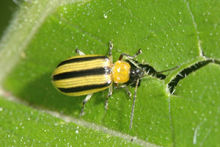
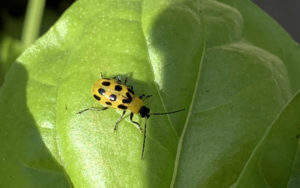
Another type of cucumber beetle is the banded cucumber beetle. It is found primarily in warmer climates. While similar in size and shape to the spotted and striped cucumber beetles, the banded cucumber beetle varies in that it has a greenish-yellow body with yellow bands that traverse its back (wings). The banded pattern may vary somewhat or be barely visible. Its head and antennae are red instead of black.
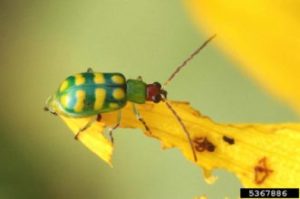
The larvae of these three types of cucumber beetles are thin, creamy white grubs with brown heads that measure approximately 1/3″ to 3/4″ in length. In this stage, the beetles are referred to as the corn rootworm.
Life Cycle
Some cold-weather adult cucumber beetles can overwinter in weeds, wood piles, compost piles, leaf litter, and other yard debris. In the spring or early summer, they will emerge to feed on weeds while they wait to find more desirable food, like plants from your garden, much like leaf-footed bugs.
Once the cucumber beetles find your garden, they will lay their eggs in the soil. Some species will lay them on the leaves and even on the flowers. The eggs are typically yellow or light orange-yellow and are laid in clusters. When the eggs hatch, the small larvae will feed on the roots below the soil level, as well as the stems of the plants. After a period of a few weeks, the larvae will reach their full size at which time they will pupate in the soil. After pupation, the adults emerge and repeat the eight-week cycle. Warmer climates may see several cycles in a growing season.
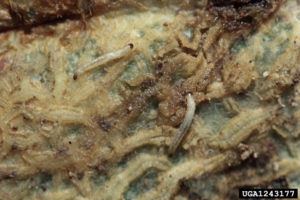
Damage to Your Garden
Cucumber beetles prefer cucumbers (hence the name), however, they will also target other cucurbits such as melons, acorn squash, zucchini, patty pan squash, pumpkins, and gourds. They also like corn which is why the larvae are called corn rootworms. But this garden pest isn’t a picky eater. You’ll also find them on beans, okra, and nightshades such as potatoes, sweet potatoes, tomatoes, and peppers. Of course, they’ll also eat peanuts, onions, peas, beets, lettuce, and grains like oats and wheat. Really, just about anything is on their menu.
Look for adult beetles on seedlings, as they enjoy eating the tender vegetation. They will also eat leaves, flowers, pollen, and fruit on more mature plants.
If that’s not enough to be concerned about, both the adult and larval stages can transmit bacterial diseases such as bacteria wilt. They also spread viral diseases such as the mosaic virus, which infects cucurbits, especially cucumbers. Unfortunately, these diseases can be devastating as they can kill plants and spread to other areas of your garden.
How to Identify Cucumber Beetle Damage
One way to know if you have cucumber beetles is that the plant’s leaves and flowers have been chewed. You may also find the stem has been girdled or that there is scarring on the fruit. If the beetle population is high enough, they will also chew the stems.
If the cucumber beetle has transmitted bacterial wilt to the plant, the leaves will discolor, and the plant will wilt. The process can occur very quickly, and within a matter of days, the plant can die.
Cucumber beetles can be very destructive, however here are eight organic methods you can take to control them.
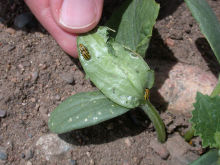
How to Control Cucumber Beetles Organically
1. Inspect Your Garden Regularly
Inspect your garden regularly for cucumber beetles, larvae, and eggs. Pay attention to sprouts and seedlings as they are particularly vulnerable to cucumber beetle damage because of their size.
You may need to start seeds indoors under grow lights to avoid presenting vulnerable seedlings to unwanted guests. The more mature plants will be able to better withstand an attack.
2. Remove the Bugs and Eggs by Hand
Remove the beetles by hand and either smash them or drop them in a container of soapy water. Because the bugs are small, this may present a bit of a challenge. One option is to put petroleum jelly on the fingertips of a pair of gloves. (You can use disposable gloves or purchase inexpensive ones from the Dollar Store.) The bugs will stick to the petroleum jelly and make removal easier.
If there are several bugs, another option would be to place a piece of cardboard or a dish towel under the plant’s leaves and shake the plant. The bugs will fall onto the cardboard or towel, and you can transfer them to a container of soapy water.
Others suggest using a vacuum to suck the beetles off of the plant if there is an infestation.
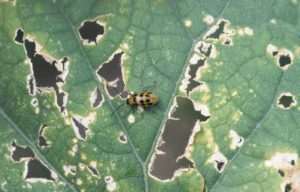
3. Introduce Natural Predators
Another way to control cucumber beetles is to introduce insect predators into your garden. Ladybugs, lacewings, soldier beetles, ground beetles, beneficial nematodes, tachinid flies, and Braconid wasps can help eliminate or control the cucumber beetle population.
This article contains affiliate links. If you make a purchase using one of these links I will receive a very small commission at no additional cost to you, and it will help me maintain this website. Rest assured, I only recommend products I actually like!
4. Apply Diatomaceous Earth
Dust your plants with food-grade diatomaceous earth (DE), a fine powder-like substance made from fossilized marine life. When an insect moves across the powder, sharp micro-fragments scrape the exoskeleton and cause it to die. For this reason, you may want to protect your eyes and avoid inhaling the powder as it could harm your lungs.
DE can harm bees and other pollinators, so be sure to dust your plants late in the day when they are no longer around and avoid dusting flowers. You will need to reapply DE if it becomes wet.
5. Apply Neem Oil
Spray your plants with neem oil, which comes from the seeds of the neem tree, an evergreen from India. It works well on a variety of insects, including squash bugs, squash vine borers, and aphids.
Unlike insecticidal soap, neem oil does not kill the insects right away. Instead, it interferes with their hormones, preventing them from reaching maturity and reproducing. The pungent oil also serves to repels insects and is considered an antifeedant. Neem oil can also help stop the progression of certain pathogens.
You can make your own neem oil spray. Start with 1-2 teaspoons of pure, cold-pressed neem oil with the naturally occurring compound, Azadirachtin (which makes it more effective). This is the neem oil I use. Mix it with 1/2 teaspoon of a Castile soap like Dr. Bonner’s or Dr. Wood’s, and 1 quart of water. Do a spray test on a leaf and wait 24 to 48 hours to see results before spraying the rest of the plant. Repeat once a week if necessary. Do not spray during the day as the combination of sun and oil could burn your plants.
6. Apply Garlic and Pepper Spray
The smell and taste of garlic and hot peppers can serve as a deterrent to the cucumber beetle. You can make your own spray by mixing several crushed garlic cloves, 1 tablespoon of dried hot peppers, and 1 tablespoon of Castile soap like Dr. Bonner’s or Dr. Wood’s, in one gallon of hot water. Let the mixture steep for one hour then cool completely. Strain the mixture and do a test spray on one leaf. If there is no negative reaction, spray the rest of the plant. Like most other sprays, do not apply when the sun is out or it could burn your plants. I use this sprayer and this sprayer for a wide variety of applications.
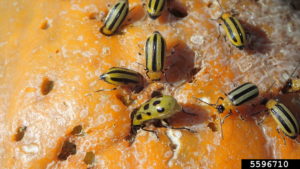
7. Apply Kaolin Clay
Kaolin clay, which consists primarily of the mineral, kaolinite, is a naturally occurring substance. It is used to make china and porcelain, as well as to treat various medical conditions. Spraying a kaolin clay mixture on your plants will create a powdery film that will act as a natural deterrent to cucumber beetles.
One resource suggests mixing 3 cups of powdered kaolin clay to one gallon of water. Mix well and do a test spray on one leaf. If all goes well, spray the entire plant, including the underside of leaves and the stem. Do not apply the spray on a sunny day as it could burn the leaves. You may need to reapply if the plants get wet.[1] Like diatomaceous earth, be careful not to inhale the powder or dust as it can cause harm to your lungs.[2]
8. Remove Diseased Plants
Cucumber beetles will be attracted to plants that have been infected by bacterial wilt. Therefore, remove infected plants and dispose of them in the trash. Do not compost infected plants.
How to Prevent Cucumber Beetles
While not foolproof, there are certain measures you can take to prevent cucumber beetles from becoming a problem. Here are several suggestions.
1. Plant bacterial wilt resistant varieties whenever possible. While this won’t deter the cucumber beetle, it could lessen the damage if they do visit your garden. It may also help to plant your crops later in the season to reduce exposure to the beetles. Also, practice crop rotation to avoid beetles that are overwintering in the soil from the previous crop.
2. Remove weeds and debris from the garden and surrounding area in order to eliminate overwintering sites.
3. Install row covers. This is especially helpful when trying to protect seedlings. You’ll need to remove them once the plants start to flower in order to give pollinators access to the flowers.
4. Use mulch around plants to deter cucumber beetles from laying their eggs at the base of your plants. If you use straw mulch, it may attract wolf spiders, which will eat the cucumber beetles. Note, however, that wolf spiders do have a painful bite, so you’ll need to keep an eye out for them.
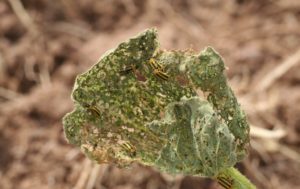
5. Plant clover, nasturtiums, marigolds, chamomile, tansy, and radishes near your cucurbits to deter cucumber beetles from making their home in your garden.
6. Kaolin clay can be used as a preventative measure as well as a control method. See the above protocol for kaolin clay.
Cucumber beetles, although small, can be a formidable pest in anyone’s garden. Taking these preventative measures, as well as following the treatment suggestions, can help minimize or eliminate the damage they can inflict.
Note: If you found this article to be helpful, please share it with someone you think might be interested in it as well. Thank you!
[1] https://www.wikihow.com/Get-Rid-of-Cucumber-Beetles
[2] http://gnarlyscience.com/kaolin-clay-pesticides/

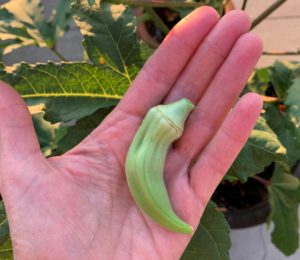

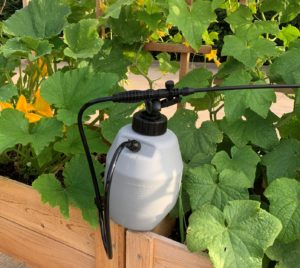
This is fantastic – Thank you for the excellent and comprehensive information. I’m pretty sure all 8 of my cucumber plants died from wilt because of these buggers. I saw a recommendation somewhere to put out a yellow bowl with soapy water and I don’t think I got a single cucumber beetle – only insects I did not want to kill:(. Glad to have these other ideas. I’m in the process of planning and setting up my garden at my new place and think I’m going to plant the pathways to clover so glad to hear that’s a potential help to curb the beetles!
Hi Stephanie,
Thanks for the kind words about the article!
So sorry to hear about your cucumber plants! That is so frustrating! But thankful you now have some possible solutions. It often takes more than one approach or method to treat pests and diseases naturally, but it is so worth it. Best wishes for a bumper crop of cukes next season!
Blessings,
Hildy
I’m battling them now. I’m also battling aphids, but ladybugs are on the scene and spreading fast, so I can’t use many of the direct application methods. I use soapy water most of the time, I find that the beetles congregate in the squash blossoms and I can get multiple in one shot. They are quick, they see me point the bottle at them, and they fly away quickly. I see the clusters of eggs, but I thought they were ladybug eggs, so I was avoiding them. My other method is essentially physical violene… if there is no time to grab the bottle, I squish them.. my wife does not approve…
Sounds like you are holding your own! Good for you! Sometimes it can be challenging, but I bet your perseverance pays off!